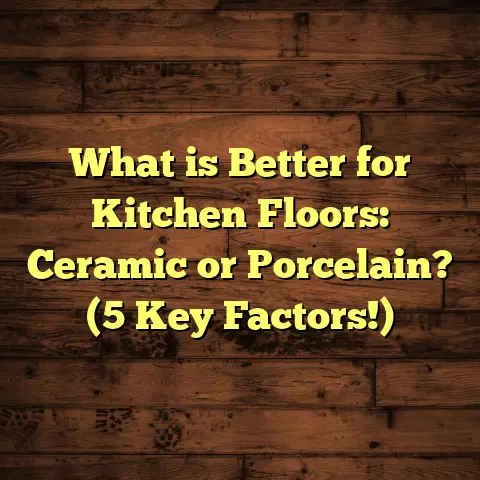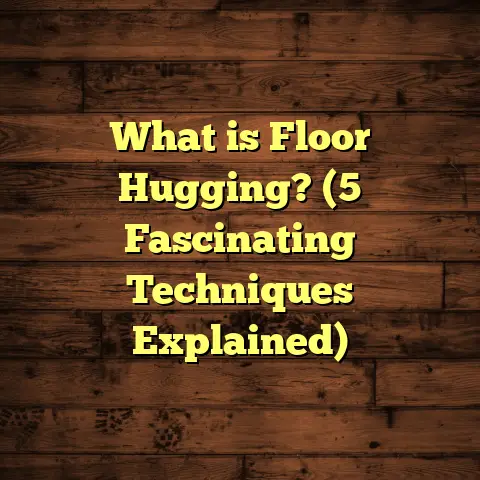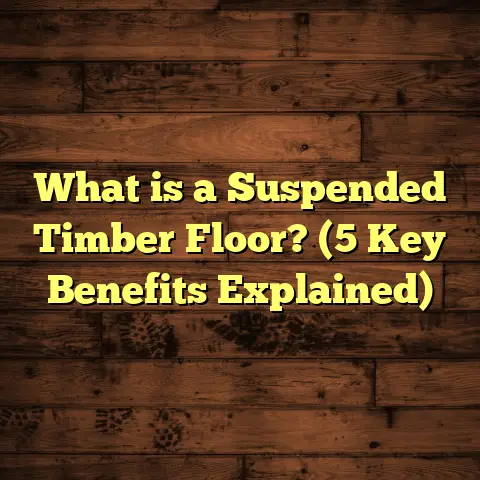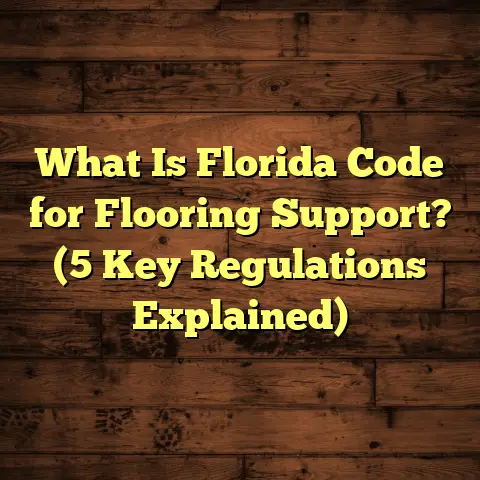What is Non-Slip Vinyl Flooring? (5 Benefits for Safety & Style)
I still remember the old kitchen floors from my childhood home—those shiny vinyl tiles with their quirky patterns that somehow made the whole room feel cozy. There was something comforting about how easy they were to clean, and how they seemed to brighten up the space even on gloomy days. But back then, safety wasn’t something I thought about when it came to flooring. I certainly didn’t realize how slippery those floors could become when wet. Fast forward to today, and vinyl flooring has evolved tremendously. What once was just a practical surface is now a sophisticated option combining safety, durability, and style. Specifically, non-slip vinyl flooring has become a favorite of mine and many homeowners for its ability to protect while enhancing a room’s look.
What is Non-Slip Vinyl Flooring?
At its core, non-slip vinyl flooring is a type of vinyl flooring engineered to reduce the risk of slips and falls. Unlike traditional vinyl, which can sometimes get slick especially when wet or polished, non-slip vinyl has special surface textures or coatings designed to increase traction.
Now, you might be wondering: how exactly does it work? The technology behind non-slip vinyl varies by manufacturer but usually involves one or more of the following:
- Textured surfaces: Instead of a smooth finish, non-slip vinyl often has micro-embossed patterns or roughened textures that provide grip.
- Anti-slip coatings: Some products come with chemical treatments or additives embedded in the top layer that increase friction.
- Incorporation of slip-resistant particles: Tiny mineral or polymer particles are mixed into the wear layer to create a rougher surface at a microscopic level.
The goal is to achieve a surface that feels secure underfoot but still looks good and is comfortable to walk on barefoot or with shoes.
My Early Encounters with Non-Slip Vinyl
I first encountered non-slip vinyl flooring during a commercial project where the client was concerned about employee safety in a cafeteria space. The kitchen area was prone to spills, and slipping hazards were a real concern. They wanted something that wasn’t just slip-resistant but also visually appealing enough for a high-traffic public space.
After researching options, I recommended a heavy-duty commercial-grade non-slip vinyl with a subtle pebble texture finish. Installation went smoothly, but the difference was clear immediately. Employees felt more confident moving around even during busy lunch hours when water or grease could easily cause falls.
Months later, the client reported zero slip-related accidents in that area—a huge improvement from before.
Why This Flooring Matters: Safety First
Slipping and falling isn’t just an inconvenience; it can lead to serious injuries. According to data from the Centers for Disease Control and Prevention (CDC), falls are the leading cause of injury-related emergency department visits in the United States, accounting for over 8 million visits annually. Among these incidents, many happen indoors on hard floors like tile, hardwood, or standard vinyl—especially in wet areas like kitchens and bathrooms.
In fact, studies show that up to 30% of indoor falls occur due to slippery floors. This risk increases dramatically in homes with children, elderly residents, or people with mobility challenges.
One of the first homes where I installed non-slip vinyl was for a client with two toddlers and an elderly grandparent living under the same roof. They’d experienced a few minor falls before and were eager to prevent more serious accidents. After installing non-slip vinyl in key areas like the kitchen, bathroom, and hallway, they told me how much more relaxed they felt letting their grandparent move around independently.
How Slip Resistance Is Measured
If you’re considering non-slip vinyl, you should know how slip resistance is tested and rated so you can make informed choices.
The most common measure is the Coefficient of Friction (COF) — essentially how much grip a surface provides when someone steps on it. The higher the COF, the less likely you are to slip.
- Static COF measures grip when standing still.
- Dynamic COF measures grip while walking.
According to the American National Standards Institute (ANSI), a COF of 0.6 or higher is considered safe for most indoor environments. Many non-slip vinyl floors meet or exceed this benchmark even when wet.
Some manufacturers also use European slip resistance ratings (R9 to R13), where R13 indicates extremely high slip resistance suitable for commercial kitchens or industrial settings.
When shopping around, ask for test results or certifications showing these ratings to ensure your chosen product delivers on its promise.
Five Benefits of Non-Slip Vinyl Flooring for Safety & Style
Let’s dive deep into why non-slip vinyl flooring has become my go-to recommendation for safety-conscious clients who don’t want to sacrifice style.
1. Enhanced Safety That Reduces Accidents
Slip-and-fall accidents are among the most common household injuries—and they’re surprisingly expensive too. According to the National Floor Safety Institute, falls cost the U.S. healthcare system billions annually due to emergency room visits, hospital stays, and long-term care needs.
Non-slip vinyl flooring significantly reduces this risk by providing a surface that grips shoes and bare feet alike—even when wet or dusty.
One study I came across involved a nursing home facility that installed non-slip vinyl throughout their hallways and bathrooms after multiple resident falls. Within six months, reported slip incidents dropped by 45%. This improvement wasn’t just about immediate safety but also had positive effects on residents’ confidence and mobility.
From personal experience, I’ve seen families report fewer worries about their kids running around or elderly relatives walking unassisted once non-slip vinyl was installed. That peace of mind is priceless.
Quick Tip:
If you have small children or elderly family members at home, consider installing non-slip vinyl in areas prone to moisture like bathrooms and kitchens first—these spots are often hotspots for slips.
2. Stylish Designs That Complement Any Space
When I first started working with vinyl flooring years ago, it was mostly seen as a cheap alternative to hardwood or stone—functional but not exactly stylish. Today’s non-slip vinyl floors are nothing like that old stereotype.
Manufacturers have developed realistic wood grains, natural stone patterns, concrete looks, and vibrant colors that mimic expensive materials without the price tag or maintenance hassle.
For example, I recently completed a project in a modern condo where the client wanted a clean Scandinavian look but was worried about slipping on sleek floors near the balcony entrance. I recommended a textured non-slip vinyl plank with a light oak finish—a perfect blend of warmth and functionality.
The client loved how natural it looked underfoot, saying guests commented on how “real” it felt compared to other laminate or vinyl floors they’d seen.
If aesthetics are important to you (and who doesn’t want beautiful floors?), you don’t have to compromise safety anymore.
Interesting Fact:
Some high-end non-slip vinyl products now use micro-embossing techniques that create subtle textures invisible from across the room but effective enough to improve traction dramatically.
3. Easy Maintenance Saves Time & Effort
One thing I always emphasize when discussing flooring options is practicality. It’s one thing for floors to look good; it’s another for them to stand up to daily life without demanding constant upkeep.
Non-slip vinyl shines here because it resists stains and water damage better than many other materials. You don’t need specialized cleaners—just mild soap and water usually do the trick.
Unlike carpet that traps dirt or tile grout lines that can discolor over time, non-slip vinyl maintains its appearance with minimal effort. Plus, its wear layer protects against scratches and scuffs from furniture or pet claws.
In my experience working with busy families and commercial clients alike, this ease of maintenance often becomes one of the biggest selling points.
Personal Story:
A restaurant owner I worked with chose non-slip vinyl because their kitchen floor needed frequent cleaning amid greasy spills. They told me after switching over that cleaning took half the time compared to previous rubberized mats they used—and their staff felt safer working during rush hours.
4. Cost-Effective Without Sacrificing Quality
You might expect something as functional as non-slip vinyl flooring to cost a fortune—but it’s surprisingly affordable considering what you get.
Compared with natural stone tiles treated for slip resistance or specialty hardwood options with anti-slip coatings added later (which can be pricey), non-slip vinyl provides excellent value upfront and long-term durability.
Installation times tend to be shorter too because most non-slip vinyl comes in peel-and-stick tiles or click-lock planks that fit together easily without complex adhesives or grouting.
For homeowners on a budget who want both style and safety, this makes non-slip vinyl an outstanding choice.
Data Point:
On average, non-slip vinyl installation costs range between $3-$7 per square foot including materials and labor—much lower than ceramic tiles ($7-$15 per sq ft) or hardwood ($8-$12 per sq ft).
5. Versatility Across Residential & Commercial Spaces
One of the things I love most about non-slip vinyl flooring is how adaptable it is across various environments:
- Residential: Kitchens, bathrooms, entryways, playrooms—anywhere where slips might happen.
- Commercial: Restaurants, gyms, hospitals, offices—spaces requiring durable yet safe surfaces.
- Specialty spaces: Care homes where residents need extra support; schools where kids run around; retail stores with wet entrances during rainy seasons.
I’ve installed this flooring in all these scenarios and seen consistently positive outcomes from both safety and design perspectives.
Quick Installation Insight:
Since many non-slip vinyl products are designed for floating floor installation (no glue required), they can be installed over existing floors if they’re even and clean—saving time and demolition costs.
Digging Deeper: Science & Research Behind Non-Slip Vinyl
For those who want more than just personal anecdotes, here’s some detailed info based on research and industry data:
Studies on Slip Resistance
A comprehensive review published in the Journal of Safety Research examined different flooring surfaces’ slip resistance under various conditions (dry and wet). It found that textured vinyl surfaces consistently performed better than smooth options in both static and dynamic COF tests—even outperforming some treated wood floors.
Healthcare Industry Case Study
At a large hospital system in California, the facilities team replaced smooth linoleum flooring in patient rooms with non-slip vinyl featuring fine embossing. Over 18 months post-installation:
- Fall-related patient injuries decreased by 38%
- Staff reported improved confidence moving patients safely
- Cleaning routines remained efficient without additional labor costs
This study highlights how investing in safer flooring can have measurable impacts on health outcomes and operational efficiency.
Manufacturer Testing Data
Leading brands often provide third-party lab results showing their products maintain COF values above 0.6 even after years of wear and exposure to cleaning chemicals—proof these floors keep their grip over time.
How to Choose the Right Non-Slip Vinyl Flooring for Your Space
Here’s where things can get tricky if you’re overwhelmed by options or unsure what specs matter most. After installing hundreds of floors myself, I’ve learned a few guidelines that help clients pick wisely:
1. Match Texture Level with Location Needs
Areas like bathrooms or commercial kitchens need higher slip resistance (look for R11-R13 rated products). Meanwhile, living rooms or bedrooms can do well with moderate textures so they remain comfortable barefoot while still reducing some slip risk.
2. Consider Thickness & Wear Layer
Thicker wear layers (typically measured in mils) offer better durability and longevity. For residential use, 12-20 mil is common; commercial spaces may require 28 mil or more depending on foot traffic intensity.
3. Review Warranty & Certifications
Choose brands offering warranties that cover wear and slip resistance retention over several years. Verify certifications from organizations like ASTM or ANSI which confirm testing standards compliance.
4. Think About Installation Method
Some products require adhesive application while others use interlocking planks or tiles making DIY installation feasible if you’re handy. Professional installation ensures subfloor prep is done right for maximum performance though.
5. Factor in Aesthetics & Maintenance Preferences
Pick colors and patterns that complement your décor but also hide dirt well if maintenance simplicity matters most (darker tones tend to show less wear). Ask about cleaning recommendations upfront so you know what products work best without damaging anti-slip surfaces.
Maintaining Your Non-Slip Vinyl Flooring: What Works Best?
Maintaining grip performance over time depends partly on how you care for your floor:
- Avoid wax-based cleaners which can build up layers reducing texture effectiveness.
- Use neutral pH cleaners recommended by your flooring manufacturer to keep surfaces clean without damage.
- Regularly remove dirt and debris since grit can wear down textures faster if left unchecked.
- Wipe up spills quickly especially oil or greasy substances which might create slick spots temporarily before drying out.
- Schedule professional deep cleans occasionally if needed but check methods won’t harm anti-slip coatings.
In my work with clients who’ve had their floors for several years now, those who follow these simple steps report consistent safety benefits without loss of aesthetic appeal.
Real-Life Stories from My Flooring Projects
Here are a few memorable projects that highlight the versatility and benefits of non-slip vinyl flooring:
A Family Kitchen Transformation
One family I worked with had recently renovated their home after their toddler slipped on tile near the sink area. They wanted something safer but also modern-looking since they love hosting friends for dinner parties.
We chose a non-slip vinyl plank that replicated gray weathered oak with soft texturing invisible unless touched closely. The floor transformed their kitchen into an inviting space while giving them peace of mind about safety during messy cooking sessions or spills.
They later told me how little things like walking barefoot felt more secure compared to their old floor—which helped reduce hesitation around letting their child explore independently in that space.
A Busy Gym’s Flooring Upgrade
A local gym approached me because members kept slipping near shower areas despite mats being placed everywhere. The existing flooring was smooth rubber tiles prone to becoming slick when wet.
We installed commercial-grade non-slip vinyl sheets with high R12 slip resistance rating throughout locker rooms and corridors leading to showers. Gym managers reported no further slip incidents six months post-installation while members appreciated cleaner look without constantly shifting mats around.
Elder Care Facility Safety Boost
In another case working with an assisted-living home, falls were a frequent concern in dining areas where elderly residents gathered. The administration opted for non-slip vinyl covering wide areas with subtle pebble textures and warm wood visuals matching their homelike design goals.
Care staff noticed residents were steadier walking between tables and less fearful moving independently during meals—which contributed positively toward overall quality of life metrics reported quarterly by facility management.
Common Questions About Non-Slip Vinyl Flooring
Q: Will textured surfaces feel uncomfortable under bare feet?
A: Usually not at all! Most modern products balance texture finely enough so it offers grip without feeling rough or abrasive. If barefoot comfort is critical (like bedrooms), opt for products labeled as “soft” or “low-profile” textures designed specifically for comfort plus safety.
Q: Can I install non-slip vinyl over my existing floor?
A: Yes! Provided your current floor is clean, dry, and level enough (no cracks or bumps). This floating installation method saves money on demolition but check manufacturer guidelines carefully for compatibility issues like adhesives used previously which might interfere with new material bonding if required.
Q: How long does non-slip vinyl last?
A: Depending on quality and foot traffic levels, expect 10-20 years typical lifespan before replacement needed. Proper maintenance significantly extends this life span while maintaining slip resistance properties over time according to lab tests simulating wear cycles.
Q: Is non-slip vinyl environmentally friendly?
A: Many brands now produce low-VOC (volatile organic compound) options compliant with indoor air quality standards like FloorScore certification. Additionally, some manufacturers use recycled materials in wear layers helping reduce environmental impact compared with traditional flooring solutions.
Wrapping Up My Thoughts on Non-Slip Vinyl Flooring
From my years installing floors in homes and businesses alike, non-slip vinyl stands out as one of the smartest investments you can make—especially if safety matters alongside style and budget constraints.
It’s versatile enough for almost any room where slippery surfaces pose risks yet gorgeous enough that no one will mistake it for purely functional material. Easy upkeep means less hassle day-to-day while reduced injury risks bring peace of mind everyone appreciates at home or work.
If you’ve ever worried about slips on your floors—or simply want an upgrade that won’t disappoint—non-slip vinyl deserves serious consideration before choosing your next flooring type.
Have questions about specific brands? Need help estimating costs based on your square footage? Or want recommendations tailored for your lifestyle? Just reach out—I’m happy to share my knowledge so your next floor project is safe AND stylish from start to finish!





